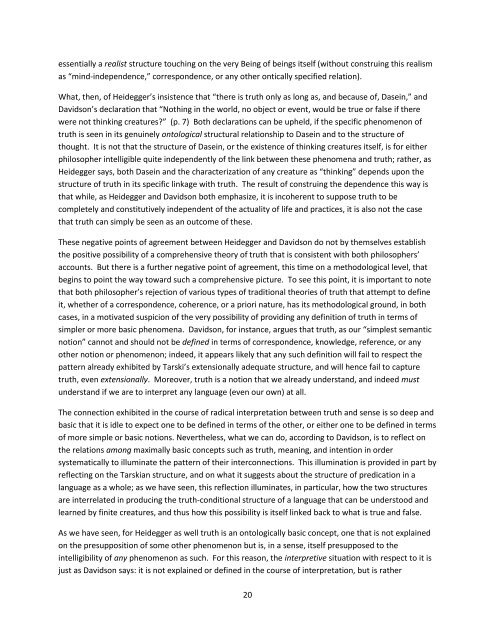Heidegger, Tugendhat, Davidson - University of New Mexico
Heidegger, Tugendhat, Davidson - University of New Mexico
Heidegger, Tugendhat, Davidson - University of New Mexico
Create successful ePaper yourself
Turn your PDF publications into a flip-book with our unique Google optimized e-Paper software.
essentially a realist structure touching on the very Being <strong>of</strong> beings itself (without construing this realism<br />
as “mind-independence,” correspondence, or any other ontically specified relation).<br />
What, then, <strong>of</strong> <strong>Heidegger</strong>’s insistence that “there is truth only as long as, and because <strong>of</strong>, Dasein,” and<br />
<strong>Davidson</strong>’s declaration that “Nothing in the world, no object or event, would be true or false if there<br />
were not thinking creatures?” (p. 7) Both declarations can be upheld, if the specific phenomenon <strong>of</strong><br />
truth is seen in its genuinely ontological structural relationship to Dasein and to the structure <strong>of</strong><br />
thought. It is not that the structure <strong>of</strong> Dasein, or the existence <strong>of</strong> thinking creatures itself, is for either<br />
philosopher intelligible quite independently <strong>of</strong> the link between these phenomena and truth; rather, as<br />
<strong>Heidegger</strong> says, both Dasein and the characterization <strong>of</strong> any creature as “thinking” depends upon the<br />
structure <strong>of</strong> truth in its specific linkage with truth. The result <strong>of</strong> construing the dependence this way is<br />
that while, as <strong>Heidegger</strong> and <strong>Davidson</strong> both emphasize, it is incoherent to suppose truth to be<br />
completely and constitutively independent <strong>of</strong> the actuality <strong>of</strong> life and practices, it is also not the case<br />
that truth can simply be seen as an outcome <strong>of</strong> these.<br />
These negative points <strong>of</strong> agreement between <strong>Heidegger</strong> and <strong>Davidson</strong> do not by themselves establish<br />
the positive possibility <strong>of</strong> a comprehensive theory <strong>of</strong> truth that is consistent with both philosophers’<br />
accounts. But there is a further negative point <strong>of</strong> agreement, this time on a methodological level, that<br />
begins to point the way toward such a comprehensive picture. To see this point, it is important to note<br />
that both philosopher’s rejection <strong>of</strong> various types <strong>of</strong> traditional theories <strong>of</strong> truth that attempt to define<br />
it, whether <strong>of</strong> a correspondence, coherence, or a priori nature, has its methodological ground, in both<br />
cases, in a motivated suspicion <strong>of</strong> the very possibility <strong>of</strong> providing any definition <strong>of</strong> truth in terms <strong>of</strong><br />
simpler or more basic phenomena. <strong>Davidson</strong>, for instance, argues that truth, as our “simplest semantic<br />
notion” cannot and should not be defined in terms <strong>of</strong> correspondence, knowledge, reference, or any<br />
other notion or phenomenon; indeed, it appears likely that any such definition will fail to respect the<br />
pattern already exhibited by Tarski’s extensionally adequate structure, and will hence fail to capture<br />
truth, even extensionally. Moreover, truth is a notion that we already understand, and indeed must<br />
understand if we are to interpret any language (even our own) at all.<br />
The connection exhibited in the course <strong>of</strong> radical interpretation between truth and sense is so deep and<br />
basic that it is idle to expect one to be defined in terms <strong>of</strong> the other, or either one to be defined in terms<br />
<strong>of</strong> more simple or basic notions. Nevertheless, what we can do, according to <strong>Davidson</strong>, is to reflect on<br />
the relations among maximally basic concepts such as truth, meaning, and intention in order<br />
systematically to illuminate the pattern <strong>of</strong> their interconnections. This illumination is provided in part by<br />
reflecting on the Tarskian structure, and on what it suggests about the structure <strong>of</strong> predication in a<br />
language as a whole; as we have seen, this reflection illuminates, in particular, how the two structures<br />
are interrelated in producing the truth-conditional structure <strong>of</strong> a language that can be understood and<br />
learned by finite creatures, and thus how this possibility is itself linked back to what is true and false.<br />
As we have seen, for <strong>Heidegger</strong> as well truth is an ontologically basic concept, one that is not explained<br />
on the presupposition <strong>of</strong> some other phenomenon but is, in a sense, itself presupposed to the<br />
intelligibility <strong>of</strong> any phenomenon as such. For this reason, the interpretive situation with respect to it is<br />
just as <strong>Davidson</strong> says: it is not explained or defined in the course <strong>of</strong> interpretation, but is rather<br />
20
















